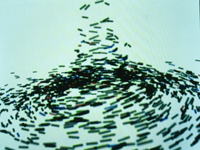1988, 1:30
This piece contains a collection of dream sequences created using 3D particle systems techniques. Behavior rules are applied to thousands of individual particles to model complex phenomena such as an explosion, a snowstorm, a tumultuous head, and a waterfall. Data-parallel computation was us
ed to perform physical simulations on thousands of particles simultaneously, one processor for each particle.
Software and Animation: Karl Sims
Sound: Robert Moore, BLC Sound
Hardware: Connection Machine CM-2
Panspermia is the name for the theory that life exists and is distributed throughout the universe in the form of germs or spores. This piece places the viewer in the middle of a virtual world of an aggressively reproducing inter-galactic life form, and depicts a single life cycle of this unusual self propagating system.
Original software was used to create and animate forests of 3D plant structures. "Artificial evolution" techniques were used to interactively select from random mutations of plant shapes until a variety of interesting structures emerged. The subject matter of the piece suggests the underlying biological methods that were used to efficiently create an unusual level of complexity. Dynamic simulations and particle systems were also employed to achieve motions that are calculated automatically.
Attempts were made to bring together several concepts: chaos, complexity, evolution, self propagating entities, and the nature of life itself. This botanical form of life, reproducing itself from planet to planet through space, is in many ways analogous to other self replicating systems including organisms, entire species, or even ideas. A window into this system, replicating on a grander scale, is meant to increase awareness of self propagating systems in general, as well as inspire thoughts about our entire planet of life as a whole entity.
Software and Animation: Karl Sims
Sound: David Atherton, David Grimes, Steve Blake, Target Productions
Thanks to: Lew Tucker, Jim Salem, Carl Feynman, Dave Sheppard, David Marvit, JP Massar, Gary Oberbrunner, & Danny Hillis
Hardware: Connection Machine CM-2






No comments:
Post a Comment